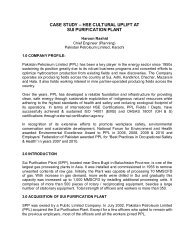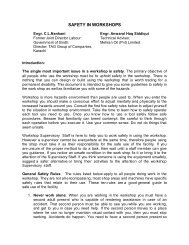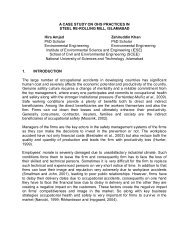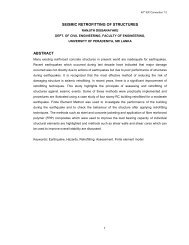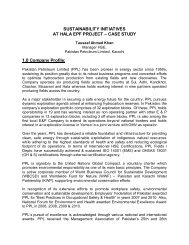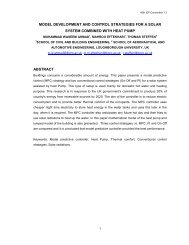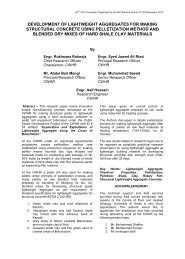OHS Practices in Food Industry - IEP Karachi Centre
OHS Practices in Food Industry - IEP Karachi Centre
OHS Practices in Food Industry - IEP Karachi Centre
Create successful ePaper yourself
Turn your PDF publications into a flip-book with our unique Google optimized e-Paper software.
Standardization (ISO) 2 . While several pieces of legislation touch <strong>OHS</strong> issues, there ishardly any concrete effort by government to develop a comprehensive environmentalhealth and safety law. In 2001, the government announced a Labor Policy Initiative andproposed to create a National Occupational Safety and Health Council (NOSHC) toreview and update the exist<strong>in</strong>g laws. However, none of that has materialized yet(Akram, 2004). Thus, Pakistan, at present, like many develop<strong>in</strong>g countries does nothave comprehensive occupational health and safety legislation. The <strong>in</strong>cidence of<strong>in</strong>juries and illnesses is probably very high <strong>in</strong> Pakistan because thousands of workersare rout<strong>in</strong>ely exposed to hazardous chemicals and harsh work<strong>in</strong>g conditions, howeverno reliable data is available to quantify this probability. The regulatory agencies do nothave an effective enforcement policy or strict requirements for report<strong>in</strong>g workplace<strong>in</strong>juries and illnesses (Awan, 2001).An overview of the exist<strong>in</strong>g laws/regulations partly related to occupational health andsafety shows several pieces of legislation, such as Factories Act, 1934; Prov<strong>in</strong>cialFactories Rules; Hazardous Occupations Rules, 1963; M<strong>in</strong>es Act, 1923; West PakistanShops and Establishments Ord<strong>in</strong>ance, 1969; Prov<strong>in</strong>cial Employees Social SecurityOrd<strong>in</strong>ance, 1965; Workmen‟s Compensation Act, 1923 and Dock Laborers Act, 1934relate to this issue (Shafi, 1986). The regulations are, however, fragmented and there isno s<strong>in</strong>gle comprehensive piece of legislation deal<strong>in</strong>g with occupational safety andhealth. The Factories Act, established <strong>in</strong> 1934 and amended <strong>in</strong> 1997, requires only avery basic level of safety and health measures. There are no guidel<strong>in</strong>es for m<strong>in</strong>imumqualifications or employment of health and safety professionals <strong>in</strong> the <strong>in</strong>dustry. Severalimportant sectors, such as agriculture, construction and <strong>in</strong>formal/self-employed are noteven covered under any law (Awan, 2002).<strong>Food</strong> <strong>in</strong>dustry is a vast <strong>in</strong>dustry that covers a wide scope. Ow<strong>in</strong>g to the very fact thatfood <strong>in</strong>dustry is one of the largest <strong>in</strong> a country, it is logical to assume that the potentialof <strong>OHS</strong> <strong>in</strong>cidents is also quite high. Figure 1 shows an <strong>in</strong>ternational trend of <strong>in</strong>juries <strong>in</strong>various <strong>in</strong>dustrial sectors compared to that of <strong>Food</strong> and Dr<strong>in</strong>k <strong>in</strong>dustry <strong>in</strong>ternationally.The food and dr<strong>in</strong>k <strong>in</strong>dustries as described here <strong>in</strong>clude animal feed manufacture butexclude distribution, retail and cater<strong>in</strong>g.2 International Organization of Standardization (ISO), Geneva, Switzerland



